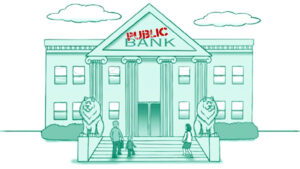
Is Now the Time for a Public Bank in New Mexico?
A Conversation with Public Bank Supporters Sarah Manning and Melissa Pickett of the Alliance for Local Economic Prosperity
A New Mexico-owned public bank is the goal of AFLEP, the Alliance for Local Economic Prosperity. Melissa Pickett and Sarah Manning of AFLEP are confident that the creation of a public bank will spur economic development in the rural areas and small towns of New Mexico, while productively using our tax dollars.
The citizens who live in New Mexico, especially those who live in small towns and rural areas, are desperately in need of financial help. A few years ago, there were approximately 60 local banks operating in New Mexico, today there are only 34. This is the result of an era of bank acquisition and mergers which began in the 1990s. Today, four big commercial banks control 45% of all deposits in the United States. Their goal is to make money for their shareholders, so they are uninterested in the kind of small loans that will foster development on the family farms and in the small towns of New Mexico. Lacking access to capital, small business owners have been forced to turn to payday lenders for the money they need to develop their businesses. Payday lenders can charge very high-interest rates of up to 100-175%, rates which strangle the borrower and consequently economic development in New Mexico.
AFLEP believes a state public bank is the answer. So, what is a public bank? It is a real bank, one which follows the same rules and regulations as the big commercial banks and is run by bankers. A New Mexico public bank would be owned by the citizens of New Mexico and operated by professional bankers. It will be a “banker’s bank,” loaning money and providing loan guarantees to local New Mexico banks and credit unions. Local banks and credit unions are engines of development; they know their customers and they know where to invest. They can make investments targeted at growing new businesses for New Mexico like renewable energy, and they can sustain the businesses and farms that are the backbone of rural New Mexico. Big, commercial banks are interested in big loans and transactions and their knowledge of the local economy is limited.
The profits generated by a New Mexico-owned public bank will be returned not to shareholders but to New Mexico citizens in the form of revenues for the state’s general fund, and a public bank will invest in New Mexico, not Wall Street. It will not have the high overhead costs associated with commercial banking such as advertising and the provision of banking services like ATMs and tellers. With less overhead, a public bank can charge its bank and credit union customers lower interest rates. This allows borrowers to pay a lower rate also.
Rising interest in a public bank-led AFLEP to commission a one-year study to define the potential role and organization of a New Mexico-owned public bank. It was conducted by outside finance experts, including retired bankers and a team from the Anderson School of Management at UNM. The study recommended that the state of New Mexico capitalize the bank at $50 million. An additional $50 million would be added from the state’s general revenue fund. That $50 million would be replenished by the state as necessary.
A public bank could do the state’s banking, thus saving the fees New Mexico now pays big commercial banks to oversee our money. A New Mexico-owned public bank could also loan money to New Mexico cities and counties and even to the state to fund small capital projects. Currently, government infrastructure projects are funded via public bonds which have expensive up-front costs. A public bank provides a way to avoid those fees.
The profits earned by a New Mexico-owned public bank would go back into the state general revenue fund. Thus, a state bank would be an engine for New Mexico’s economic development, especially in our rural areas. It would also save local governments and state governments the money they currently pay big commercial banks. New Mexico’s taxpayer dollars would be invested in New Mexico and the profits from the bank would be returned to the state to keep the cycle going.
The big issue is education; a lack of understanding can be the death of a new idea. AFLEP’s goal is to provide information about what a state bank is and what it can do for New Mexico to as many voters, legislators, and state officials as possible. Currently, support is growing and AFLEP hopes to see legislation introduced in the next session of the state legislature.
If reading this article has convinced you that a New Mexico-owned public bank is a worthy idea, Melissa and Sarah hope that you will contact your legislators and urge them to create a public bank.
For more information, check out the Alliance for Local Economic Prosperity webpage at https://aflep.org.
